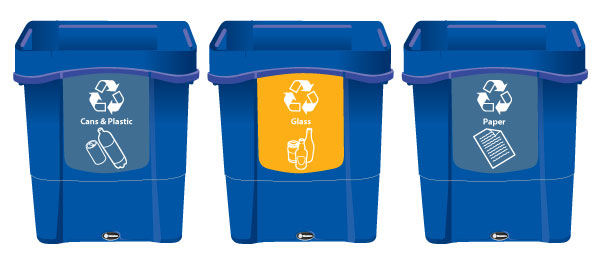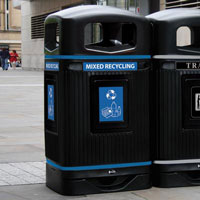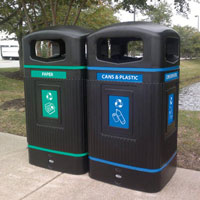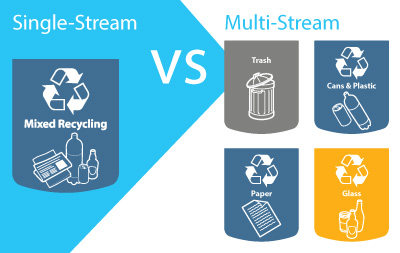The debate of single-stream recycling vs multi-stream recycling is an ongoing topic. So we want to help you answer the questions of “What are the benefits of single-stream recycling and multi-stream recycling” and “Which recycling stream is best for me?”
Multi-stream recycling refers to the process of separating recyclables by material type prior to collection. These recycled materials are then kept separate throughout the whole of the recycling process. This type of recycling may also be known as source-separated recycling, dual stream recycling or sorted stream recycling.
Conversely, single-stream recycling is the collection of all recyclables in one container. Single-stream recycling may also be referred to as mixed recycling, commingled recycling or single-sort recycling. The collected materials are then sorted into separate recycling streams further along the recycling process at a Materials Recovery Facility (MRF).

What Factors Affect Recycling Stream Choice?
Various factors can influence which recycling method you use for your company. Both single-stream recycling and multi-stream recycling are beneficial in their own ways, meaning there is no clear winner. However, you may find that one type is more suitable for your recycling needs than the other.
There are many factors to consider when choosing a recycling stream, including (but not limited to!) the following elements:
Curbside Recycling
Does your town offer curbside recycling? If so, curbside collection may influence whether you choose to follow the single-stream or multi-stream recycling method. For instance, in 2014 over 80% of jurisdictions* in California reportedly offered single-stream recycling curbside collection for residential and commercial sites.
In most cases where curbside collection is accessible, a single jurisdiction may provide more than one type of curbside recycling program. However, some regions in the United States do not have access to a curbside recycling program at all. For these regions, we recommend focusing on improving trash collection or looking at the availability of other recycling programs.
Government Regulations
Certain Governmental rules regarding recycling may be set for your state or city. For instance, as of 1 August 2017, all businesses in New York City are required, by law, to have an effective recycling program in place or else they will be fined. This can be either single-stream or multi-stream recycling, but businesses will need to have their chosen method authorized with a private hauler.
Hauler Availability
The availability of haulers in your area may also be a defining factor in you decision on which recycling program to use. In some regions, haulers may only be able to offer collection services for a specific recycling method. Further factors surrounding waste and recycling haulage can also be influential on your decision, such as transportation costs and distance to the nearest hauler.
Nearby Material Recovery Facilities
Local Material Recovery Facilities tend to exist in regions where there is enough recyclable materials being generated and recycled. Some areas will have a multitude of MRFs at their doorstep, allowing you to choose between single-stream or multi-stream recycling. But this is not the case for all areas of the United States.
If a local MRF isn’t accessible in your region, that doesn’t mean you can’t recycle. Hub and spoke recycling models are common in rural areas without access to local MRFs. Hub and spoke recycling refers to a process where numerous communities work together to collect recyclables and transport them to a centralized MRF for processing. Colorado government** suggest communities using hub and spoke models should aim to collect source-separated recyclables.
Population Density
Large metropolitan areas tend to be more likely to offer citizens and organizations a choice of recycling programs than smaller, less populated towns. This is largely due to populous regions having more recycling resources available such as a larger number of MRFs, wide choice of private and public haulers and more economic backing for recycling.
What are the Advantages of Single-Stream Recycling?
Convenience
Single-stream recycling certainly streamlines the recycling process for consumers as they can easily throw all of their recyclables into one container with barely a second thought. This is great for convenience, making it a suitable choice to increase recycling participation levels, especially in busy environments.

Recycling Rates
Naturally, a single-stream recycling program is better than none at all! Before the City of Boston first implemented single-stream recycling in 2008 the amount of collected recycling was 19,000 tons. By 2012 the amount of collected recyclables was report to have risen to 32,000 tons***. This increase in collected recycled materials demonstrates the benefits of single-stream recycling for diverting recycled materials from landfill.
Collection Costs
The collection costs for single-stream recycling are also significantly lower per household than the collection costs for multi-stream recycling****, where separate haulers are needed for different recycling streams. Single-stream recycling can reduce the number of refuse trucks required and reduce the amount of time taken to collect recycling.
Is Multi-Stream Recycling Better than Single-Stream Recycling?
Many organizations are still switching to single-stream recycling from dual-stream recycling today. Single-stream may be the best choice for users, but is it the best for creating an economically and environmentally green community compared to multi-stream recycling? Let’s explore some of the advantages of multi-stream recycling...
Reduced Loss of Plastics
Whilst consumer don’t need to worry about separating recyclables in single-stream recycling, somebody still needs to sort them. The task of separating recycled materials is passed onto the MRF. The MRF Material Flow Study***** reported a loss of 3% and 12% of plastics to the paper stream during the sorting process at single-stream MRFs. In the dual stream recycling MRF, there was a reduced loss of plastics to the paper stream. This suggests that multi-stream recycling is more accurate at diverting recyclables from landfill by ensuring recycled materials are correctly sorted.

Minimized Contamination
With single-stream recycling, there is a higher chance of cross-contamination in comparison to multi-stream recycling. A 2011 study by the Oregon Department of Environmental Quality****** found 9-10 percent of single-stream recycled materials were contaminants. As consumers are required to separate recyclables prior to collection, multi-stream recycling reduces contamination levels.
Improved Quality
The quality of materials recovered can also be improved by multi-stream recycling, thanks to the reduced level of contamination. Broken glass and plastic residuals that end up in the paper stream can impact the quality of paper produced at the paper mill.
Susan Collins, Director of the Container Recycling Institute, states “mixing everything together is convenient but leads to wet paper and bits of broken glass that can’t be sorted”. While single-stream may have higher recycling rates, the quality of those recovered materials are often lessened.
Cost-Effective
Multi-stream recycling is a more cost-effective waste management solution. Sure, on the face of things single-stream recycling looks like it saves more money but when you look at the costs of processing, multi-stream recycling comes out on top. Although an analysis by JPC/SERA******* found single-stream recycling resulted in a saving of $10-20 per ton for collection, it also ensued an additional cost of $5-15 per ton for processing and an increased cost of $5-13 per ton for recovered fiber at paper mills. When you add up all the costs throughout the recycling process, multi-stream recycling is the most economic choice.

Should I Choose Single-Stream or Multi-Stream Recycling?
There are clear benefits to both single-stream recycling and multi-stream recycling. Deciding which method of recycling to use may depend on the specific circumstances of your company or community. We suggest weighing up the pros and cons of both recycling methods in relation to your organization and region.
Single-stream recycling systems increase user convenience, making it a great way to introduce recycling into your business or society. This recycling stream is especially useful if you have limited space, high foot-traffic or restricted hauler options.
If you already have a single-stream recycling program in place but would like to further increase your recycling rates, improve the quality of recycled materials and potentially reduce associated costs, it may be worth considering switching to a multi-stream recycling program.
At Glasdon, we offer a variety of single-stream and multi-stream recycling containers. We are confident that our wide range of recycling bins will help you to reduce your environmental and economic impact.
Did you know? Graphics and signage can help improve diversion rates - Take a look at our ‘How important are graphics & signage?’ FAQ next for more info!
*http://www.calrecycle.ca.gov/publications/Documents/1554/201601554.pdf
**https://www.colorado.gov/pacific/cdphe/hub-and-spoke-recycling-model
***http://www.writtenbybarbaramoran.com/wp-content/uploads/2013/10/Globe-Recyling-2013.pdf
****https://archive.epa.gov/wastes/conserve/tools/localgov/web/html/collection.html
*****http://www.cartonopportunities.org/sites/default/files/files/MRF%20material%20flow%20study%20JULY%202015.pdf
******http://www.oregon.gov/deq/FilterDocs/CommingledRecyclablesBAProcessing.pdf
*******http://www.container-recycling.org/assets/pdfs/AFPA-PaperQualitySingleStream-3-04.pdf




